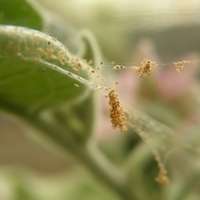Fertilisers play key role in reducing crop pests

While "preventative medicine" is well-known in human health, it's becoming a buzz word in crop production as researchers discover how the risks of damage by pests and diseases may increase if crops don't get enough nutrients to protect themselves.
A new study published in the current volume of Computers and Electronics in Agriculture journal has found that fertilisers can help reduce the risk of crop pest infestations.
Lead author Associate Professor Christian Nansen, from UWA's Institute of Agriculture and School of Animal Biology, said the study revealed a well-known pest - spider mites - had a strong and persistent preference for crop leaves with low levels of potassium.
"Potassium is a key element in standard crop fertilisers and plays an important role in growing plants," said Professor Nansen, whose position is funded by the Grains Research and Development Corporation (GRDC).
"Potassium fertilisation leads to increased leaf thickness, stronger epidermal cells and decreases leaf nutrient concentrations of sugars and amino acids so potassium can lower the suitability of crops as hosts for pests and can slow the development and spread of pests."
Professor Nansen said an important side-effect of using fertiliser to reduce the risk of pest infestation in crops was that it could lead to less need and use of pesticides.
"Although our study focused on spider mites in maize and corn plants, the findings are highly relevant to growers of other crops in WA and elsewhere in Australia," he said.
"Canola needs more potassium than wheat - especially after post-flowering which is when key canola pests become a problem - and many WA soils are deficient in potassium. So we are keen to investigate how 'smart fertiliser applications' (applied at the right dose at the right time during crop development) can be used as part of an integrated pest management strategy."
The study also showed a strong link between "spectral reflectance" of crop canopy (based on use of advanced imaging technology to characterise the spectral reflectance of crop leaves) and the attractiveness of these crop leaves to spider mites.
As crop attractiveness appeared to be associated with potassium content, the researchers argue that it may be possible to develop remote sensing systems which collect spectral reflectance data from crop leaves to continuously monitor their attractiveness during the growing season and apply fertiliser when there appears to be an increase in crop attractiveness to pests.
Provided by University of Western Australia

















